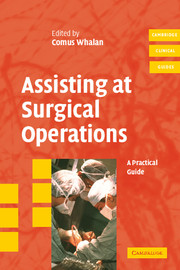Book contents
- Frontmatter
- Contents
- Contributors
- Foreword
- Preface
- PART I Introduction to the operating theatre
- PART II The operation itself
- PART III Assisting at special types of surgery
- 11 Cardiothoracic surgery
- 12 Laparoscopic surgery
- 13 Neurosurgery
- 14 Obstetric and gynaecological surgery
- 15 Ophthalmic surgery
- 16 Orthopaedic surgery
- 17 Otorhinolaryngology-head and neck surgery
- 18 Paediatric surgery
- 19 Plastic surgery and microsurgery
- 20 Surgery in difficult circumstances: (1) Rural hospitals
- 21 Surgery in difficult circumstances: (2) Developing countries
- 22 Vascular surgery: (1) Open surgery
- 23 Vascular surgery: (2) Endovascular surgery
- PART IV Immediately after the operation
- Glossary
- Suggested further reading
- References
- Index
19 - Plastic surgery and microsurgery
Published online by Cambridge University Press: 18 December 2009
- Frontmatter
- Contents
- Contributors
- Foreword
- Preface
- PART I Introduction to the operating theatre
- PART II The operation itself
- PART III Assisting at special types of surgery
- 11 Cardiothoracic surgery
- 12 Laparoscopic surgery
- 13 Neurosurgery
- 14 Obstetric and gynaecological surgery
- 15 Ophthalmic surgery
- 16 Orthopaedic surgery
- 17 Otorhinolaryngology-head and neck surgery
- 18 Paediatric surgery
- 19 Plastic surgery and microsurgery
- 20 Surgery in difficult circumstances: (1) Rural hospitals
- 21 Surgery in difficult circumstances: (2) Developing countries
- 22 Vascular surgery: (1) Open surgery
- 23 Vascular surgery: (2) Endovascular surgery
- PART IV Immediately after the operation
- Glossary
- Suggested further reading
- References
- Index
Summary
Introduction
Plastic surgeons perform many types of procedures to correct deformities and reconstruct tissue defects. The specialty covers all age groups and body areas. Consequently, you may encounter plastic surgeons working with most other specialties, at some point or other. If you are assisting at small cases you may be the only assistant, whereas in large cases there may be two or three surgeons and two scrub teams (see p. 2). One thing that is common to all plastic surgeons is that they are sticklers for good technique. Therefore, you should show care in handling all body tissues.
Plastic surgical terms
Graft
This is a piece of tissue (usually skin) that is detached from one area of the body (the donor site) and then placed on another area, such as a wound (the bed). At the end of the procedure it does not have a blood supply, but will acquire this from the bed over the next few days, rather like rolls of bare-rooted turf taking root in the underlying soil. The process of gaining this blood supply is termed ‘graft take’. Obviously therefore, a graft can only be used on a bed that has an adequate blood supply. For example, a graft cannot be used to cover a wound with a large metal plate in the centre of the bed (just as a roll of turf will not survive on bare rock).
Flap
This is a piece of tissue (skin, muscle, bone or viscera) that is moved from one area of the body to another, but which continues to receive its blood supply from the normal blood vessels it contains.
- Type
- Chapter
- Information
- Assisting at Surgical OperationsA Practical Guide, pp. 149 - 158Publisher: Cambridge University PressPrint publication year: 2006

